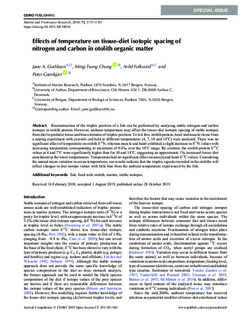Effects of temperature on tissue-diet isotopic spacing of nitrogen and carbon in otolith organic matter
Journal article, Peer reviewed
Published version
Permanent lenke
http://hdl.handle.net/11250/2640157Utgivelsesdato
2019Metadata
Vis full innførselSamlinger
- Articles [3012]
- Publikasjoner fra CRIStin [3070]
Sammendrag
Reconstruction of the trophic position of a fish can be performed by analysing stable nitrogen and carbon isotopes in otolith protein. However, ambient temperature may affect the tissue–diet isotopic spacing of stable isotopes from diet to predator tissue and bias estimates of trophic position. To test this, otolith protein, heart and muscle tissue from a rearing experiment with juvenile cod held at different temperatures (4, 7, 10 and 14°C) were analysed. There was no significant effect of temperature on otolith δ15N, whereas muscle and heart exhibited a slight decrease in δ15N values with increasing temperature corresponding to maximum of 0.6‰ over the 10°C range. By contrast, the otolith protein δ13C values at 4 and 7°C were significantly higher than for 10 and 14°C, suggesting an approximate 1‰ increased tissue–diet enrichment at the lower temperatures. Temperature had no significant effect on muscle and heart δ13C values. Considering the annual mean variation in ocean temperatures, our results indicate that the trophic signals recorded in the otoliths will reflect changes in diet isotope values with little bias from the ambient temperature experienced by the fish.
